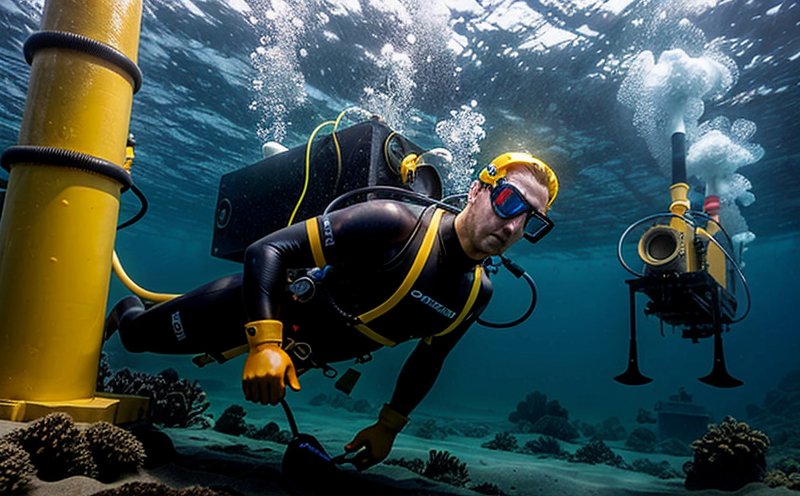API 17TR8 Fatigue Testing of Subsea Risers
The API 17TR8 specification is a critical standard in the offshore oil and gas industry, ensuring that subsea risers are capable of withstanding the dynamic loading conditions they encounter during operation. This service focuses on fatigue testing to verify the structural integrity and durability of these components under cyclic loading.
Subsea risers play a pivotal role in connecting production platforms to the seabed, facilitating the transport of hydrocarbons from the reservoir to the surface. The environment in which they operate is harsh, with constant exposure to water currents, temperature variations, and biological fouling. The API 17TR8 specification provides guidelines for the design, fabrication, and testing of these risers to ensure reliability and safety.
The fatigue testing process involves subjecting a specimen of the subsea riser to repetitive loading cycles that mimic real-world conditions. This helps in identifying potential failure points before deployment. The test setup typically includes a hydraulic or pneumatic testing rig capable of simulating the cyclic loading experienced by the riser during its operational life.
The fatigue testing procedure can last several weeks, depending on the specimen's material properties and expected service life. During this time, detailed monitoring of deformation, strain, and stress is conducted using advanced instrumentation such as load cells, displacement transducers, and strain gauges. The data collected during these tests are crucial for evaluating the riser’s performance under cyclic loading.
One of the key aspects of API 17TR8 fatigue testing is ensuring that the specimen is representative of the actual subsea riser. This includes using similar materials, dimensions, and manufacturing processes. The test setup must also replicate the environmental conditions as closely as possible, which can involve controlled temperature chambers and salt spray facilities.
The results of API 17TR8 fatigue testing are reported in compliance with the specification’s requirements. These reports include detailed descriptions of the specimen used, the testing parameters, the observed deformation and failure modes, and any discrepancies from the expected outcomes. The findings are invaluable for quality assurance and form the basis for further design improvements.
| Standard | Description |
|---|---|
| API 17TR8 | Specification for subsea riser design, fabrication, and testing. |
| American Society of Testing Materials (ASTM) | Standards on materials used in the construction of subsea risers. |
| International Organization for Standardization (ISO) | General standards that apply to various aspects of industrial practices. |
Scope and Methodology
The scope of API 17TR8 fatigue testing encompasses the evaluation of subsea risers for their resistance to cyclic loading. This testing is designed to identify any potential weaknesses or areas prone to failure, ensuring that the equipment meets stringent safety and performance criteria.
Methodologically, the process begins with selecting a representative specimen from the production batch. The specimen is then subjected to a series of cyclic loadings in a controlled environment. The testing rig used for this purpose must be capable of simulating the dynamic loading conditions experienced by subsea risers during their operational life.
The methodology includes detailed monitoring of various parameters such as displacement, stress, and strain using high-precision sensors. These instruments provide real-time data that is crucial for assessing the specimen’s performance under cyclic loading. The testing continues until either a predefined number of cycles is reached or the specimen shows signs of fatigue failure.
The results are analyzed to determine the fatigue life of the subsea riser, which is expressed in terms of the number of load cycles before failure occurs. This information is vital for assessing the reliability and durability of the equipment. The analysis also includes a comparison with the design specifications, ensuring compliance with industry standards.
- Selection of representative specimen
- Controlled cyclic loading simulation
- Detailed monitoring using advanced instrumentation
- Data analysis for fatigue life assessment
Quality and Reliability Assurance
Ensuring the quality and reliability of subsea risers is paramount in the offshore oil and gas industry. The API 17TR8 fatigue testing service provides a robust framework for achieving this goal by adhering to rigorous standards and employing advanced testing techniques.
The process begins with meticulous specimen preparation, ensuring that the test sample accurately represents the final product. This includes precise cutting, polishing, and cleaning of the material to eliminate any surface irregularities or defects. The testing environment is also critical; it must replicate real-world conditions as closely as possible, including temperature, humidity, and saltwater exposure.
Advanced instrumentation plays a crucial role in ensuring the accuracy and reliability of the test results. Load cells, displacement transducers, and strain gauges are used to monitor various parameters during the cyclic loading process. These instruments provide real-time data that is essential for assessing the specimen’s performance under stress.
The testing methodology itself is designed to be highly precise and repeatable, with strict adherence to API 17TR8 guidelines. The results of each test are meticulously documented, ensuring transparency and traceability throughout the process. This documentation includes detailed reports on specimen preparation, testing parameters, observed deformation and failure modes, and any deviations from expected outcomes.
The service also emphasizes continuous improvement through feedback loops that incorporate lessons learned from previous tests. This iterative approach ensures that the testing process evolves to meet emerging standards and industry best practices.





